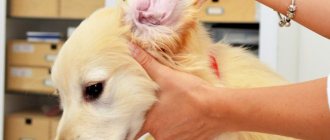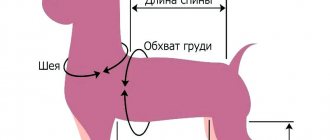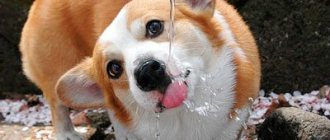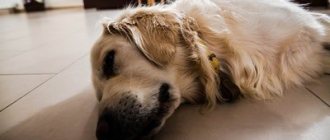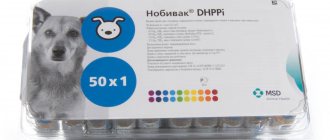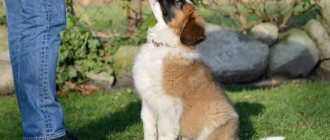Grooming your dog should not be done occasionally, but regularly. In particular, we are talking about ear care and cleaning. This procedure is not performed when the ears are dirty or there is some discharge, but regularly for hygienic purposes. Periodic examination is necessary in order to reduce the risk of possible bacterial and fungal diseases, prevent the occurrence of inflammatory processes or the appearance of ectoparasites. This seemingly simple procedure must be performed correctly; it has certain features and rules.
Do dogs need to have their ears cleaned and why?
A four-legged pet receives almost a third of information about the outside world through the organs of hearing. Sounds are the most important part of an animal’s life; it is guided by them in most cases.
The dog's ears regularly become dirty: dust and dirt, water get into them, and insects fly in. Contamination of the ear canal in an animal is fraught with the appearance of serious diseases. This is why maintaining dog ear hygiene is extremely important.
Regular cleaning of the external auditory canal will help prevent not only the development of infectious diseases, but will also prevent serious inflammatory processes. The examination allows you to timely identify possible pathological conditions in the ear canal:
- tumors;
- hematomas;
- redness;
- increased release of sulfur;
- presence of an unpleasant odor.
Ear hygiene is one of the necessities along with brushing teeth, trimming nails and trimming fur. Ear cleaning at home should be done regularly throughout the animal's life.
How to Determine Cleaning Frequency
Depending on the breed of the dog, the frequency of procedures is regulated. So, some pets need to be cleaned literally every day or at least every other day. These are long-haired breeds with floppy ears. The ventilation of the ears of these dogs is worse than that of short-haired breeds with erect ears. You should also take into account the age of the animal and its lifestyle.
In dogs with erect ears
How often to clean your dog's ears depends on the breed of the animal. Some popular breeds are advised to have their ears cleaned with additional guidelines.
Ear examinations should be weekly for all breeds, but cleaning is approximately:
- once a week for lop-eared dogs;
- once every two weeks for breeds with erect ears.
The ears of some short-haired breeds require special care. These include the German Shepherd - this breed is especially valued for its good hearing. Cleaning is a mandatory procedure performed weekly to maintain the dog’s working qualities. The same recommendations apply to other service and guard breeds.
Dogs with long ears
Dust, dirt, and earwax accumulate more quickly on the surface of long ears. And since long ears are less ventilated, this leads to debate and the development of pathogenic microorganisms and fungus. Therefore, fold-eared breeds need to clean their ears more often than pets with erect ears.
Be sure to be wary if dirt regularly accumulates in the ear or if your pet behaves restlessly, scratches its ears, or shakes its head. These are the first symptoms of diseases. Take your dog to a specialist to rule out health problems. If you regularly groom your dog, but dirt is constantly accumulating in the ears, it is better to consult a veterinarian to avoid causing the problem.
Some breeds with erect ears also require painstaking care: this applies to those animals that have thick and long hair growing in their shells. It prevents ventilation and creates favorable conditions for the development of harmful microorganisms. The ears of such pets are examined at least once a week, and for hygiene purposes the hairs in the ear canals are shortened.
How to care for a girl Yorkshire Terrier
Basic care does not depend on the gender of the animal. However, if you have a girl Yorkshire Terrier, then there are periods in her life that require special attention, such as estrus, as well as pregnancy and childbirth
SIMILAR ARTICLES
BEST FOOD FOR YORKSHIRE TERRIER
How to choose the best food for your Yorkshire Terrier based on a comparison of products from leading manufacturers. Examples of wet...
YORKSHIRE TERRIER: DESCRIPTION OF THE BREED, STANDARDS, HOW LONG DO YORKIES LIVE
Yorkshire Terrier: description of the breed according to the standard, character and developmental characteristics of dogs, life expectancy, advantages and...
CREATIVE HAIRCUT FOR YORKSHIRE TERRIERS
The most popular creative Yorkie haircut, ideal for babyfaces. This sweet and naive face is at its peak...
HOUSE FOR YORKSHIRE TERRIER
A house for a Yorkie? What are you talking about! This is a super sociable, curious dog who strives...
WHEN AND HOW TO VACCINATE YORKSHIRE TERRIER PUPPIES
Why do Yorkie puppies get vaccinated? When and how vaccination is carried out, against what diseases. Preparation…
IS IT ALLERGY TO YORKSHIRE TERRIERS?
Many breeders believe that the Yorkshire Terrier is a hypoallergenic dog that can be safely owned by a person…
YORKSHIRE TERRIER - HISTORY OF THE BREED
Today the Yorkshire Terrier is one of the most popular and famous dog breeds, but few people think about…
HOW TO TRAIN A YORKSHIRE TERRIER TO NAPPY
Diaper training a Yorkshire Terrier is very helpful for people with busy daily routines, so as not to...
HOW TO WASH YOUR YORKSHIRE TERRIER CORRECTLY
It’s worth learning how to wash a Yorkie because the condition of your pet’s coat depends on it. For Yorkie...
CLOTHING FOR DOGS. HOW TO DRESS A YORKIE
Every owner of a Yorkshire Terrier understands that his little friend is also a member of the family and...
WHY DOES THE YORKSHIRE TERRIER GRUNTS?
The sniffling and grunting of a dog may seem cute from the outside and is most often a feature of the breed, but...
How to clean a dog's ears
There are a huge number of ear cleaning products available. It is very easy to get lost in this diversity. When choosing a dog ear cleaner, you should clearly understand how each of them works.
Special lotions and powders
Special lotions from veterinary pharmacies dissolve dirt and earwax, which is removed by massaging, with a dry cloth or by shaking the ears with the dog itself. Popular lotions include SaniPet, Trixie, Otifree, Ear Cleansing Liquid, Nutri-Vet, Iv San Bernard CLEAN EAR, Chris Christensen MYSTIC EAR and others.
For dogs belonging to long-eared breeds, it is recommended to use a special powder that has a drying effect. First you need to clean the ear with the product, and then apply the powder. It will improve ventilation in your ears, which will help prevent dirt buildup.
Pharmacy products
Lotions for cleaning dogs' ears can be replaced with medications that are sold at any pharmacy. These include:
- Hydrogen peroxide
. It is more convenient to purchase a bottle equipped with a pipette. Simply place a few drops in your dog's ear and then wipe them and any lather with a cotton pad.
- Chlorhexidine
. The solution has disinfectant properties. It is recommended to use it in case of wounds or other damage. Too frequent use of chlorhexidine provokes dry skin and dermatological diseases, so it is used only for healing purposes.
- Saline solution
. A small amount of the product is applied to a cotton pad and wiped over the ear. Saline solution is good for dogs with erect ears.
- Boric alcohol
. It is not recommended to use the product without a doctor's prescription. To administer alcohol, use a pipette, pour a few drops into each ear, then wipe them off with a cotton pad. Acts as a medicinal, and not as a hygienic, product; it is used for otitis of varying degrees of severity.
- Vishnevsky ointment
. Has an anti-inflammatory and healing effect. It is used if there are wounds and damage to the auricle.
- Miramistin
. It has a more gentle, but similar disinfecting effect.
Despite the widespread use of all of the above remedies, veterinarians do not recommend their use without indications. If you just need to clean your dog's ears, use a special lotion from a veterinary pharmacy.
Folk remedies
Folk remedies are widely used in veterinary medicine. If you urgently need to clean your pet’s ears, but you don’t have either peroxide or lotion on hand to clean the ears, then you can use folk remedies. The following infusions are suitable for this:
- chamomile;
- a line symbolically called a dog walker;
- mint;
- calendula;
- green tea.
You can use sea buckthorn, vaseline and other types of oils. A solution of sea salt, along with herbs, is considered an effective remedy; it cleanses earwax well and dries the surface of the animal’s ears. If you don’t have anything at hand, feel free to use tea leaves.
How to clean a dog's ears at home: instructions
Regular ear care is not at all difficult and does not require the help of specialists. You can handle this procedure yourself, the main thing is to carry it out carefully, following all the rules of implementation.
What you will need
The set for this hygiene procedure is very modest. Here's what you'll need:
- Wet or regular cloth wipes. They are moistened with special cleaning solutions.
- Cotton wool, cotton swabs or cotton pads. They are necessary to dry the ears after applying lotions. Cotton wool or cotton pads are also used to very carefully clean the external auditory canal.
- Special cleaning lotion for dogs. This is a product specially designed for caring for dogs' ears.
- A special powder designed for cleaning the ears of lop-eared breeds. Just like lotion, it is used for regular care without the use of additional products.
- Hydrogen peroxide or saline solution. The use of hydrogen peroxide is advisable when there are no special means at hand.
- Medicinal products. Necessary if there is damage or inflammation in the ear. Use only after consultation with a veterinarian.
When caring for dog ears, it is unacceptable to use aggressive chemicals, such as vinegar or alcohol-containing solutions. This is fraught with chemical burns and hearing impairment. If this is your first dog, consult your veterinarian or an experienced breeder.
Preparation
Cleaning your dog's ears can be quite unpleasant and off-putting. As a result, cleaning the ears turns into torture for the animal and the owner. To understand how to properly clean a dog’s ears, you need to learn to feel your pet and find an approach to it.
Before starting the procedure, introduce your four-legged friend to the equipment and materials, and also let him smell the liquids that you will be working with.
You need to build the dog’s trust and let him relax as much as possible. Before the procedure, you can wash your pet (if he likes it) and give a soothing massage to the ears.
Accustoming should be gradual and begin with daily examinations of the auricle. During cleaning, you must constantly talk kindly to the dog, stroke and calm it.
How to properly clean a dog's ears
The process of caring for dog ears is not difficult - if the dog is accustomed to it and trusts you, it will take no longer than 2-4 minutes. How the cleaning works:
- Call your pet and inspect its ears. It is important that the dog is calm and not afraid or nervous. If the animal struggles, you can inadvertently injure it.
- Straighten the auricle if it is a drooping ear, and fill the ear canal with a special product.
- From the outside, massage your ear so that the lotion is evenly distributed throughout the ear canal. This is necessary so that all accumulations of sulfur are softened as much as possible.
- Then dry the visible parts of the ear with a cotton pad or cotton wool. If the pet wants to shake its ears, do not interfere, this will help shake out the excess lotion.
- It is better to clean the folds of the ear with cotton swabs. But do not use them to clean the ear canal - it may cause injury.
- Use different wipes, cotton swabs or pads for different ears to avoid transferring infection from one ear to another.
- After the procedure, do not forget to reward your pet.
Perform the procedure regularly, and then your pet will endure it with due calm and without fear. If you are cleaning your puppy's ears, choose a state when he is sleepy and inactive - after a hearty meal or a long walk.
What to avoid
Never use cotton swabs to deep clean the ears of dogs. The stick can damage the ear canal if you move the dog’s hand or head carelessly.
Also, do not use gauze wrapped around your finger for cleaning. After such treatment, particles of tissue and threads remain in the dog’s ear canals, which are very difficult to remove.
Do not use ethyl alcohol or treat the ears with soap, shampoo, gel, or vinegar essence - the animal will inevitably receive a burn or irritation. Do not pour oil extracts into your animal's ears: this will glue the villi inside the ear and may cause blockage of the ear canal. Soaps and baby lotions contain additives that are harmful to dogs and can cause an allergic reaction.
Only get the correct information about cleaning such an important organ for a dog as the ears from a specialist. Before using a new lotion, ointment, or gel, you should ask your veterinarian whether this product can be used to clean your dog's ears - this product may not be suitable for your breed. The same goes for medications.
How to clean
There are some animals that simply accumulate more sulfur than others. There are dirty people who always fall head over heels in mud - literally.
And even if not, and nature took care of your pet, you still need to know how to clean your ears. Otherwise, when the need arises, you will have to study urgently, and this will not add joy to anyone.
Preparing the dog
For the procedure, the animal does not require any special preparation, except for the habit of obeying the owner and trusting him. But it is better, of course, if it is accustomed to cleaning in advance and is calm about it.
Choice of product
BARS Ear Lotion
When a person needs to perform ear hygiene, he usually takes a cotton swab. For animals, there are much more means:
- Lotions. The most popular option because it works simply: pour a little product inside the ear canal and massage the shell until the dirt and wax are corroded and can be easily wiped off - or even allow the pet to shake itself.
- Napkins, cotton pads and sticks. Interchangeable, required only to wipe off excess wax and remove lotion residue. It is not recommended to carry out the procedure without emollient liquid agents - there is too great a chance of erasing the protective layer from the epithelium.
- Wet wipes for cleaning. An analogue of lotion, it allows you to erase wax.
- Tweezers. With rounded ends that cannot be hurt. It is used when you need to get something out - debris or a tick that has gotten inside.
For breeds whose ears lie close to their heads, there is also a special powder. Small, white, it is used to sprinkle the epithelium from the inside, reduce the production of sulfur and remove moisture. With powder, dirt does not accumulate, and the dirt that does get inside can be easily shaken out by the animal itself.
Cleaning process
The first thing to remember is that it is much more difficult to damage the eardrum in canines than in humans. It is located in the depths, behind the bend, and it is not easy to reach it with a wand. Therefore, you shouldn't be too nervous.
However, the fact that it is difficult to cause harm does not mean that you can act carelessly. The skin is sensitive, it is easy to scratch, and even easier to remove the protective layer from it. And any pain for the dog will be a reason to resist the next cleaning.
Therefore, by the way, you shouldn’t record it either. This will help carry out the procedure, but all the next times the animal will run away and hide, because it will remember that when it is held, it always hurts afterwards, which means you need to not let yourself be caught.
The process proceeds sequentially:
- The dog is seated in a quiet, calm place. It’s good if he’s tired after a walk and has just eaten, then he won’t want to resist. In addition, it is good if the examination is combined with something else, for example, with searching for wounds on the body, washing paws, combing, and it will become habitual.
- Inspect the sink. Pass it over it with a cotton pad - lightly. If the color is pink, no special dirt is visible, the animal does not complain and gives in easily, and only a faint yellowish or brownish coating remains on the disc, then everything is fine, no cleaning is required.
- If a thick brown residue remains on the disc, there is too much sulfur. You need to take a dry napkin, roll it into a flagellum and gently wipe off the excess. If the dog is large, you can wrap a napkin around your finger.
- If a trace with lumps remains, it means not only a lot of sulfur, but also dirt has accumulated. You need to pour a little lotion inside, press the shell to your head and massage. And then remove the residue with a napkin or cotton pad - or let the dog shake its head.
- If the burdock is visible inside, remove it with tweezers. If there is a tick, pull it out by the head, and then treat the skin with miramistin. Alcohol solutions cannot be used, they will have a bad effect on local immunity and will leave a burn.
If the dog twitches, whines, tries to remove its head, or even snaps, despite the fact that usually there were no such problems, then you need to contact the veterinarian with a corresponding request - there is a high chance that it is otitis media or the skin inside is damaged.
The whole procedure takes two minutes if the pet is well mannered and does not interfere.
Video
What to do if your dog won't let you clean your ears
If an adult dog does not allow its ears to be cleaned, then most likely the owner has made a number of mistakes while teaching the animal to the procedure. But everything can be fixed with desire and patience.
Since you will have to clean your dog’s ears at home regularly, it is important not to be nervous and to be as relaxed as possible with the animal every time. Call your dog as often as possible several times a day, just pet him on the head and give him a treat if he allows you to touch his ears. In this way, the dog will gradually become accustomed to examinations.
Next, the touches are replaced by lifting and massaging the ears. The next time you call, hold your hands on your pet’s ear a little longer, look inside, praise and let him go for a walk. Each subsequent training session adds time to examining the ear; you can gradually try to wipe the visible part of the auricle with a bandage without touching the ear canal. It is important to let the dog understand that ear cleaning is not scary, and after the manipulations there must be a treat.
If the dog leaves without allowing you to clean its ears, you cannot punish it physically: you can just show it, but not give it a treat. Any raised voice will form an unpleasant association with cleaning, so rude and stern tones are best avoided.
If your pet trusts you, he will willingly put his ears at your disposal. Therefore, the owner should try to do everything in a calm, friendly atmosphere, without intimidating. The dog must be in a good mood - after eating, immediately after washing, cleaning can be combined with other procedures (for example, grooming). For the first time, you may need an assistant.
In difficult cases, the dog does not allow you to brush your teeth and ears, cut your nails, or even wash yourself, because it does not recognize the person as a leader. Here, to achieve results, behavior correction is required - most likely, the effect will only come from classes with an instructor. As soon as the animal recognizes the person as the owner, problems with hygiene will disappear by themselves.
How to accustom a dog to the procedure
What to do if your dog won't let you clean your ears? Not all animals have a positive attitude towards hygiene procedures. It's best to gradually introduce your pet to ear cleaning when he's still a puppy. An older dog can be trained to brush just like a young one, and here contact with the owner, especially visual, is extremely important. At first, call the dog to you, stroke its head, touch its ears, and then just let it go. Extend contact daily, touch the ears, lift them, massage them.
Much depends on the breed of the dog. For example, terriers will take longer to get used to than others. After the cleaning is complete, give your dog a treat and reward him for enduring the procedure courageously. The pet will understand that there is nothing wrong with this, and subsequently will willingly agree to all hygienic manipulations.
